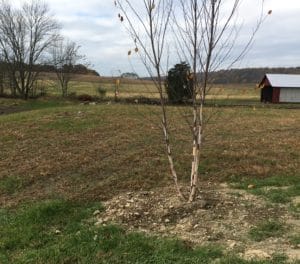Hello fellow readers,
While the fall planting season is wrapping up, there’s still time to plant most species of woody plants. Good thing as Gail and Rich of Sparta NJ have a naked garden dilemma since a new neighbor moved in who opted to take down a glorious stand of Canadian hemlock (Tsuga canadensis) that provided privacy between them. The trunks of the forty-foot-tall hemlocks were on the neighbor’s side who felt the trees impeded the vast views of Lake Mohawk. It’s sad to see mature native trees cut down. Gail and Rich kept them healthy, protecting them from woolly adelgid and other diseases over the thirty-two years they’ve lived there. Though its true, now the magnificent wide view of the lake has been revealed.

A No-No! No large trees should be planted close to a septic – especially stay clear of Birch (Betula) and others…
In terms of adding new screening for privacy, the dilemma is Rich and Gail have a septic field in the vicinity, installed in 2000, and are concerned about protocols regarding planting near it. Most experts agree no large trees should be planted close to a septic field and there are a few species especially to stay clear of such as Elm (Ulmus), Birch (Betula), Maple (Acer), particularly Silver and Red Maples, Walnut (Juglans), Willows (Salix), Beech (Fagus), Poplar (Populus), Pine (Pinus) and, perhaps it goes without saying, bamboo of any kind. These woody plants seek water and are drawn to the nutrients of soil surrounding a septic field, therefore, they should be at least fifty feet away. In fact, the overall rule of thumb is all woody plants should be planted as many feet from the field as is their height at maturity which limits Gail and Rich’s goal to recreate a tall screening between them and their new neighbor. The thing is the hemlocks, there before the new septic, where close to field for the eighteen years with no issues of root entanglements as far as they know. But in all good conscience, we must follow the rules within a range of reasonable.
Trees with shallow roots structures to consider include our native Eastern redbud (Cercis canadensis) – gorgeous Pink Panther blooms coat their branches in early spring before they leaf-out. There are ornamental trees such as Japanese maple (Acer palmatum), Dogwood (Cornus), Cherry (Prunus), Crabapple (Malus), and Smoke Tree (Cotinus) that would work well too.
In terms of evergreens, Rich and Gail have seen success in their deer-ridden neighborhood with ‘Green Giant’ arborvitae (Thuja) that quickly grow to forty to sixty feet high, but their spread is only twelve to eighteen feet. Hence their root structure will likely remain narrow. We’re planning a grouping of Green Giants amongst an assortment of flowering ornamental trees to provide screening and seasonal displays of color without hiding the newfound panoramic views. Indeed, change can be good.
Garden Dilemmas? AskMaryStone@gmail.com
A previous article on Growing Around a Septic


